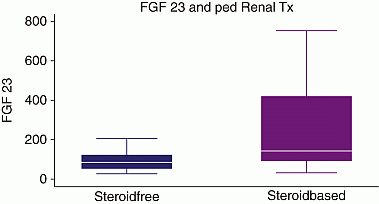ICCBH2013 Oral Communications Miscellaneous (6 abstracts)
Fibroblast Growth Factor 23 Plasma Levels Are Elevated with Early Chronic Kidney Disease and Positively Associated with Steroid Based vs Steroid Free Immunosuppression in Pediatric Renal Transplant Patients
Rachana Srivastava 1, , Poyyapakkam Srivaths 1, & Eillen Brewer 1,
1Baylor College of Medicine, Houston, Texas, USA; 2Texas Childrens Hospital, Houston, Texas, USA. *Winner of New Investigator Award
Background: Fibroblast growth factor 23 (FGF23) is a circulating phosphaturic hormone that also suppresses renal 1α-hydroxylase activity. In adult patients (pts) plasma FGF23 increases in early stages of chronic kidney disease (CKD), even before serum phosphorus changes. In a study of 984 adult renal transplant pts, higher FGF23 levels were independently associated with increased risk of all-cause mortality and allograft loss during 39 months follow-up2. Few studies have focused on FGF23 and CKD in immunosuppression in pediatric (ped) renal transplant (Tx) pts.
Aim: Determine plasma FGF23 and evaluate potential associations with renal function and mineral metabolism parameters in ped Tx pts.
Methods: Cross-sectional study of 59 ped Tx pts (21F; median age 15.2 years, range 3.9–21.8 years; 25 Hispanic/17 White/16 Black/1 other) with CKD stages 1–3 (mean±S.D. Schwartz eGFR 97±25 ml/min per 1.73 m2); median time since Tx 1.2 years (range 0.16–11.1 years). Immunosuppression was 47 pts steroid free (SF) and 12 steroid based (SB). Serum Cr, Ca, P, iPTH, 1,25vitD; plasma C-terminal FGF23 by ELISA; and urine Ca, P, and Cr were measured. 12/59 pts (209%) were on P supplements for hypophosphatemia for age. 13/59 pts (25%) were prescribed calciferol, and 4/59 pts (7%), calcitriol.
Results: 17/59 pts (28.8%) had plasma FGF23 >140 RU/ml (normal±2 S.D.=69±39 in healthy controls in two ped studies). Plasma FGF23 levels were not associated with gender, age, ethnicity, time since Tx, tubular reabsorption P (TRP), or serum P, iPTH, or 1,25vitD. Elevation of plasma FGF23 was the only mineral metabolism abnormality associated with lower eGFR to CKD stages 2–3 (Table). Plasma FGF23 was higher in pts receiving SB vs SF (206±207 vs 95±67 RU/ml, P=0.004).
| eGFR Schwartz (ml/min per 1.73 m2) | Serum Ca (mg/dl) | Serum P (mg/dl) | iPTH (pg/ml) | 25vitD (ng/ml) | 1,25vitD (pg/ml) | TRP (%) | FGF23 (RU/ml) |
| eGFR ≥90; n=35 | 9.9 (9.6, 10.2) | 4.1 (3.6, 4.6) | 62 (35, 104) | 19 (12, 23) | 67 (55–87) | 85 (81–89) | 73 (49, 113) |
| eGFR 30–89; n=24 | 9.7 (9.4, 9.9) | 4.4 (3.2, 4.7) | 63 (39, 163) | 22 (18, 27) | 47 (39–60) | 84 (80–88) | 113* (93, 164) |
| 1. Values as median (interquartile range); *P=0.0003, CKD 1 vs CKD 2–3. | |||||||

Conclusions: In ped renal Tx pts with CKD stages 2–3 plasma FGF23 is the earliest mineral metabolism marker of decreasing GFR. Elevated FGF23 is strongly associated with steroid-based transplant immunosuppression, suggesting an effect of steroids on FGF23 metabolism in ped renal Tx pts. Longitudinal study of this pediatric renal Tx population will be needed to assess whether early elevation of plasma FGF23 predicts increased risk for worsening graft function/loss.
 }
}



